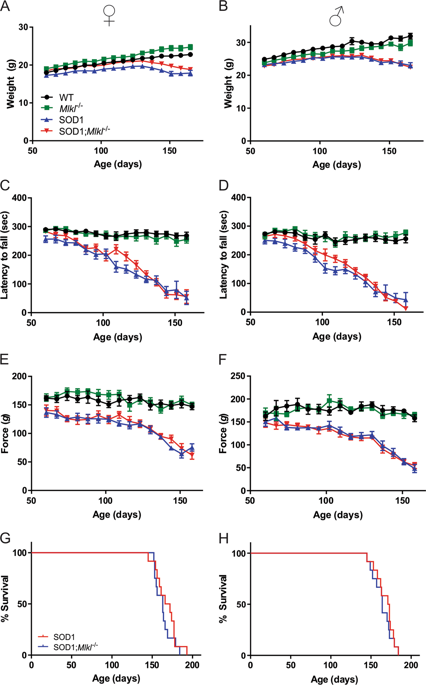当前位置:
X-MOL 学术
›
Cell Death Differ.
›
论文详情
Our official English website, www.x-mol.net, welcomes your
feedback! (Note: you will need to create a separate account there.)
Necroptosis is dispensable for motor neuron degeneration in a mouse model of ALS.
Cell Death and Differentiation ( IF 13.7 ) Pub Date : 2019-11-19 , DOI: 10.1038/s41418-019-0457-8 Taide Wang 1 , Nirma D Perera 1 , Mathew D F Chiam 1 , Brittany Cuic 1 , Nayomi Wanniarachchillage 1 , Doris Tomas 1 , André L Samson 2, 3 , Wayne Cawthorne 2 , Eric N Valor 4 , James M Murphy 2, 3 , Bradley J Turner 1
Cell Death and Differentiation ( IF 13.7 ) Pub Date : 2019-11-19 , DOI: 10.1038/s41418-019-0457-8 Taide Wang 1 , Nirma D Perera 1 , Mathew D F Chiam 1 , Brittany Cuic 1 , Nayomi Wanniarachchillage 1 , Doris Tomas 1 , André L Samson 2, 3 , Wayne Cawthorne 2 , Eric N Valor 4 , James M Murphy 2, 3 , Bradley J Turner 1
Affiliation

|
Motor neuron degeneration in amyotrophic lateral sclerosis (ALS) is proposed to occur by necroptosis, an inflammatory form of regulated cell death. Prior studies implicated necroptosis in ALS based on accumulation of necroptotic markers in affected tissues of patients and mouse models, and amelioration of disease in mutant superoxide dismutase 1 (SOD1G93A) mice with inhibition of the upstream necroptotic mediators, receptor interacting protein kinase 1 (RIPK1), and RIPK3. To definitively address the pathogenic role of necroptosis in ALS, we genetically ablated the critical terminal executioner of necroptosis, mixed lineage kinase domain-like protein (MLKL), in SOD1G93A mice. Disease onset, progression, and survival were not affected in SOD1G93A mice lacking MLKL. Motor neuron degeneration and activation of neuroinflammatory cells, astrocytes, and microglia, were independent of MLKL expression in SOD1G93A mice. While RIPK1 accumulation occurred in spinal cords of SOD1G93A mice in late stage disease, RIPK3 and MLKL expression levels were not detected in central nervous system tissues from normal or SOD1G93A mice at any disease stage. These findings demonstrate that necroptosis does not play an important role in motor neuron death in ALS, which may limit the potential of therapeutic targeting of necroptosis in the treatment of neurological disorders.
中文翻译:

坏死性坏死对于ALS小鼠模型中的运动神经元变性是必不可少的。
肌萎缩性侧索硬化症(ALS)中的运动神经元变性被认为是由坏死病(一种调节性细胞死亡的炎性形式)发生的。先前的研究基于在患者和小鼠模型的受影响组织中的坏死性标记物的积累,以及在突变型超氧化物歧化酶1(SOD1G93A)小鼠中疾病的改善与ALS的坏死性疾病相关,同时抑制了上游坏死性介质,受体相互作用蛋白激酶1(RIPK1)和RIPK3。为了明确解决坏死病在ALS中的致病作用,我们在SOD1G93A小鼠中遗传消融了坏死病的关键终末执行者,即混合谱系激酶域样蛋白(MLKL)。在缺少MLKL的SOD1G93A小鼠中,疾病的发作,进展和存活率不受影响。运动神经元变性和神经炎性细胞,星形胶质细胞,小胶质细胞和小胶质细胞与SOD1G93A小鼠中的MLKL表达无关。尽管在晚期疾病的SOD1G93A小鼠的脊髓中发生RIPK1积累,但在任何疾病阶段,正常或SOD1G93A小鼠的中枢神经系统组织中均未检测到RIPK3和MLKL表达水平。这些发现表明,坏死病在ALS的运动神经元死亡中不发挥重要作用,这可能限制了在治疗神经系统疾病中以坏死病为治疗靶点的潜力。
更新日期:2019-11-19
中文翻译:

坏死性坏死对于ALS小鼠模型中的运动神经元变性是必不可少的。
肌萎缩性侧索硬化症(ALS)中的运动神经元变性被认为是由坏死病(一种调节性细胞死亡的炎性形式)发生的。先前的研究基于在患者和小鼠模型的受影响组织中的坏死性标记物的积累,以及在突变型超氧化物歧化酶1(SOD1G93A)小鼠中疾病的改善与ALS的坏死性疾病相关,同时抑制了上游坏死性介质,受体相互作用蛋白激酶1(RIPK1)和RIPK3。为了明确解决坏死病在ALS中的致病作用,我们在SOD1G93A小鼠中遗传消融了坏死病的关键终末执行者,即混合谱系激酶域样蛋白(MLKL)。在缺少MLKL的SOD1G93A小鼠中,疾病的发作,进展和存活率不受影响。运动神经元变性和神经炎性细胞,星形胶质细胞,小胶质细胞和小胶质细胞与SOD1G93A小鼠中的MLKL表达无关。尽管在晚期疾病的SOD1G93A小鼠的脊髓中发生RIPK1积累,但在任何疾病阶段,正常或SOD1G93A小鼠的中枢神经系统组织中均未检测到RIPK3和MLKL表达水平。这些发现表明,坏死病在ALS的运动神经元死亡中不发挥重要作用,这可能限制了在治疗神经系统疾病中以坏死病为治疗靶点的潜力。









































 京公网安备 11010802027423号
京公网安备 11010802027423号